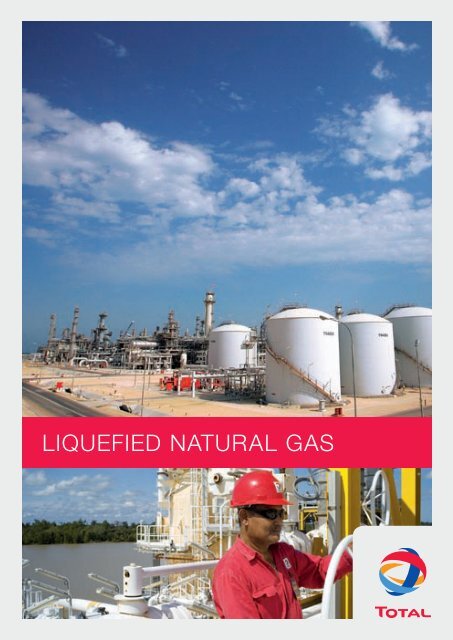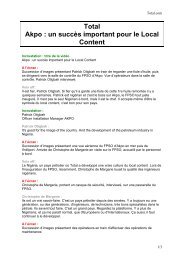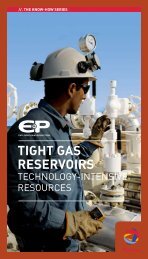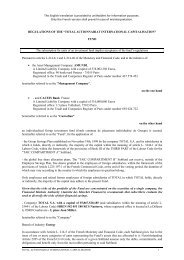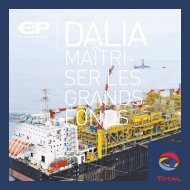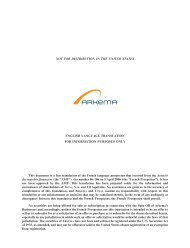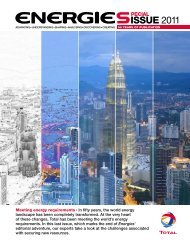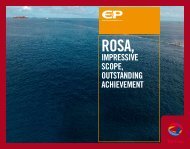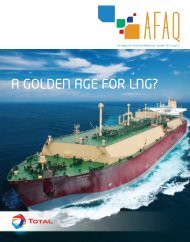Liquefied Natural Gas (pdf - 2.32 MB) - Total.com
Liquefied Natural Gas (pdf - 2.32 MB) - Total.com
Liquefied Natural Gas (pdf - 2.32 MB) - Total.com
Create successful ePaper yourself
Turn your PDF publications into a flip-book with our unique Google optimized e-Paper software.
LiqueFieD NATurAL GAS
2<br />
4<br />
8<br />
The benefits of a<br />
clean energy source<br />
The LNG market<br />
Liquefaction<br />
14<br />
16<br />
Shipping<br />
Regasification<br />
Trading and<br />
20 marketing<br />
22<br />
24<br />
<strong>Total</strong>, innovating<br />
in LNG technology<br />
<strong>Total</strong>’s LNG<br />
activities worldwide
Jean-Marc Hosanski<br />
Senior Vice President, LNG<br />
<strong>Total</strong> <strong>Gas</strong> & Power<br />
Over the last two decades, liquefied natural gas has grown in importance<br />
to be<strong>com</strong>e a vital element in the global natural gas balance.<br />
Consumption of LNG is growing very strongly – by about 7% per year –<br />
and despite the economic downturn that began in 2008, its share of the gas market<br />
is rising steadily as well. LNG met around 7% of world gas demand in 2008 and<br />
this figure is projected to rise to nearly 11% in 2015.<br />
The traditional LNG markets (Northeast Asia, europe and North America) as well<br />
as emerging markets (india, China and South America) clearly appreciate<br />
the advantages of an energy source that is at once energy-efficient, clean, and<br />
as easy to transport as liquid hydrocarbons.<br />
in this context of strong growth, <strong>Total</strong>, which was among the LNG industry<br />
pioneers, is backed by very solid positions in the upstream and downstream<br />
segments of the gas chain.<br />
Our objective is to increase our LNG production by developing new projects.<br />
in this respect, 2009 has been a watershed year for <strong>Total</strong>: the start-up of two<br />
major liquefaction projects – qatargas 2 and Yemen LNG – will in the short term<br />
allow the Group to boost its LNG production by 50%. Other projects under<br />
way or under study in Nigeria, Angola, Australia, russia and iran will permit<br />
the pursuit of production growth through the decade 2010-2020.<br />
Our ability to guarantee sales for our liquefaction projects is a decisive advantage<br />
in meeting these objectives, which is why we have been strengthening<br />
our downstream LNG presence. <strong>Total</strong> has acquired interests in four receiving<br />
terminals – in india, Mexico, France and the united Kingdom – and has reserved<br />
large-scale regasification capacity in a terminal in the united States.<br />
We are now studying further import terminal projects, including one in Croatia<br />
intended to supply Southern europe.<br />
By consolidating our portfolio of customers in these growing markets and<br />
securing physical access to markets as well, we are in a position to purchase<br />
LNG ourselves, thereby facilitating the launch of new upstream projects.<br />
1
2<br />
THE BENEFITS OF A CLEAN ENERGY SOURCE<br />
Global demand for natural gas is growing faster than demand for<br />
other fossil fuels, largely because of its environmental advantages.<br />
Combustion of natural gas does not produce heavy unburned<br />
<strong>com</strong>pounds and also generates less greenhouse gas emissions,<br />
thanks to its high hydrogen content.<br />
<strong>Gas</strong>-fired power plants not only help to meet steadily expanding<br />
demand for electricity, with savings in construction time and capital<br />
costs, but with cogeneration and <strong>com</strong>bined-cycle technologies,<br />
they also have limited environmental impact because they are extremely<br />
energy efficient. This means that more usable energy is produced<br />
from less natural resources. Leveraging natural gas resources is<br />
therefore a critical challenge.
Safety throughout the LNG chain<br />
Production, handling, transportation and storage of LNG – and this is true<br />
of all inflammable substances – involve unavoidable risks. So all possible care<br />
is taken during project design and daily operations to maintain the highest<br />
possible safety standards.<br />
Maintaining integrity<br />
everything about an LNG project – choice of sites for the<br />
liquefaction plant, loading facilities and regasification<br />
terminal; sizing of equipment; selection of technologies to<br />
be used – is carefully studied so as to ensure optimum asset<br />
integrity. Meteorological extremes and seismic risks are<br />
also duly taken into account. Optimum safety distances<br />
are calculated for each plant site, provision is made for<br />
permanent monitoring, and emergency equipment, such as<br />
retention tanks and fire-fighting systems to curb the<br />
consequences of a potential leak, are always included.<br />
<strong>Total</strong> is participating in a number of advanced research<br />
projects to more accurately assess risks and thereby<br />
improve facilities design, operating procedures and,<br />
where necessary, evacuation conditions. The Group also<br />
contributes to the industry’s international initiatives to<br />
enhance LNG shipping and storage safety through its<br />
participation in the Society of international <strong>Gas</strong> Tanker<br />
and Terminal Operators (SiGTTO), which oversees<br />
<strong>com</strong>pliance with stringent construction and operating<br />
standards for LNG carriers and terminals.<br />
Patrice Le<strong>com</strong>te<br />
Senior Vice President,<br />
Health, Safety,<br />
Environment & Sustainable<br />
Development,<br />
<strong>Total</strong> <strong>Gas</strong> & Power<br />
The application<br />
of the highest safety<br />
standards in the design and<br />
construction of the facilities,<br />
constantly improved risk<br />
management and the<br />
promotion of a strong safety<br />
culture in our operations are<br />
basic rules and imperatives.<br />
<strong>Total</strong> implements<br />
internationally recognized<br />
safety management systems<br />
that demand constant<br />
vigilance and a <strong>com</strong>mitment<br />
to progress.<br />
3
4<br />
THE LNG MARKET<br />
LNG trade has grown at a remarkable pace.<br />
Traded volumes have increased at an average rate of around 7% a year<br />
from 2000 to 2008 and exceeded 230 billion cubic meters in 2008.<br />
LNG, helping to interconnect gas markets<br />
The world gas market is still basically regional and<br />
characterized by long-term contracts and different pricing<br />
formulas in each zone, but this regional separation is now<br />
weakening.<br />
This is because cargos of LNG, unlike pipeline gas, can<br />
be easily diverted to a new destination, with the strong<br />
increase in logistic capacity in the past few years (LNG<br />
carriers and regas terminals) now futher enhancing<br />
flexibility. Therefore it is possible to arbitrate between<br />
different import markets and sell at the best price.<br />
The LNG segment thus plays a balancing role between<br />
world gas markets. So far, this arbitrage phenomenon<br />
involves only limited volumes of gas but its importance<br />
will grow as the share of LNG in world gas consumption<br />
increases. This will result in a much stronger correlation<br />
between markets that were previously independent.<br />
indeed, this can already be observed between the united<br />
States (Henry Hub) and the united Kingdom (NBP).
New opportunities and new markets<br />
The relative importance and the role played by LNG differ significantly<br />
in the three main markets: Asia, europe and North America.<br />
Nevertheless, LNG’s growth potential in each region is high, for a variety<br />
of reasons. At the same time, new markets are emerging.<br />
In Europe<br />
At present, LNG accounts for 10% of gas demand (and<br />
22% of imports). But this percentage is increasing<br />
steadily and LNG consumption is projected to increase<br />
very significantly in the <strong>com</strong>ing years, rising from<br />
57 billion cubic meters in 2008 to 130 billion in 2015.<br />
In Asia<br />
LNG satisfies nearly all gas demand in Japan, South Korea<br />
and Taiwan, which together account for around two-thirds of<br />
the world market.<br />
Northeast Asia is a mature market, long dominated by<br />
national and regional import monopolies but now<br />
experiencing sweeping changes from increased <strong>com</strong>petition<br />
between regional players. As monopoly positions are being<br />
challenged more and more, a need has arisen for more<br />
flexible and diverse supply mechanisms, with more emphasis<br />
on short- and medium-term contracts in particular.<br />
The Chinese and indian markets offer extraordinary growth<br />
potential for the LNG industry in Asia.<br />
Japan, a thirst for LNG<br />
Japan has been the world’s largest importer of LNG<br />
for nearly 40 years.<br />
in 2008, the country accounted for 40% of the global<br />
market, importing 69 million metric tons, up 3% from<br />
2007. With 2/3 of imports used for power generation<br />
and 1/3 fed into the grid for industrial, <strong>com</strong>mercial<br />
and household use, LNG currently meets a little more<br />
Masaki Yamada<br />
LNG Marketing Manager,<br />
LNG Division, <strong>Total</strong> <strong>Gas</strong> & Power<br />
In the early 2000s, the first signs of deregulation<br />
in Japan’s energy sector, strong growth in Asian LNG<br />
markets and stiffer <strong>com</strong>petition among LNG producers<br />
led <strong>Total</strong> to strengthen its LNG marketing presence<br />
in Japan. An LNG office was set up in Tokyo to capitalize<br />
on the proximity of the LNG players in Northeast Asia<br />
(Japan, South Korea and Taiwan), which is still the<br />
Market liberalization is remodeling the landscape.<br />
New customers are emerging, numerous receiving<br />
terminals are being built, and even though long-term<br />
contracts are still the rule, there is strong growth in<br />
short-term and spot trades.<br />
in China, demand for gas is growing fast and neither the<br />
country’s dynamic domestic production nor its pipeline<br />
import contracts can meet current needs. in this favorable<br />
context, LNG imports are expected to increase by an<br />
estimated 15% a year. China is now securing its imports<br />
via a growing number of long-term LNG purchase<br />
contracts and is building the necessary receiving<br />
facilities.<br />
in india, the steady growth of energy demand and<br />
insufficiency of domestic gas resources, at least in the<br />
short term, are spurring interest in LNG, particularly for<br />
power generation.<br />
than 13% of Japan’s primary energy needs. Given this<br />
country’s energy security and environmental concerns,<br />
Japan’s LNG imports are bound to increase even<br />
further in the <strong>com</strong>ing decades. To handle the growing<br />
import volumes, Japan already boasts 27 LNG<br />
receiving terminals (a record that is likely to stand for<br />
some time) and additional facilities are now under<br />
construction.<br />
biggest import market in the world, and to leverage<br />
new growth opportunities in the region.<br />
The specific mission of the Tokyo office is to analyze<br />
market trends, identify new opportunities for short,<br />
medium and long-term supply contracts, and make<br />
appropriate marketing re<strong>com</strong>mendations to other<br />
<strong>Total</strong> units, working closely with the LNG team in Paris.<br />
Our local presence also means that <strong>Total</strong> can respond<br />
faster to new trading opportunities, in cooperation<br />
with <strong>Total</strong> <strong>Gas</strong> & Power Ltd.<br />
5
6<br />
In North America (Canada, United States, Mexico)<br />
until recently, LNG played only a marginal role in North<br />
America’s overall natural gas consumption, with annual<br />
imports fluctuating between 10 and 25 billion cubic<br />
meters, depending on demand and the price of local<br />
pipeline gas. However, the situation is evolving rapidly. in<br />
the last few years supply has diversified (input of non-<br />
The United States: regulator<br />
of global LNG flows?<br />
With the start-up of numerous new LNG projects launched<br />
in the mid-2000s – in qatar, Yemen, russia, indonesia, … –<br />
available volumes of LNG will increase spectacularly<br />
in 2010-2012/13. in some markets, this will temporarily<br />
lead to a supply surplus. Given the flexibility and the<br />
considerable size of the uS gas market (three times larger<br />
than the world LNG market), the united States will no<br />
doubt play a key role in absorbing a significant part of<br />
A BOOMING ENERGY SEGMENT<br />
Today, LNG accounts for more than a quarter of the<br />
international gas trade, a figure that is forecast to rise<br />
conventional gas) and major regasification capacity has<br />
been added. Factoring in the steady growth in gas demand<br />
in this zone, as well as the important role being played by<br />
non-conventional gas (attractive at varying prices) in u.S.<br />
domestic gas production, demand for LNG is expected<br />
to reach 40 to 70 billion cubic meters by 2015.<br />
these LNG volumes. This additional inflow of LNG will<br />
serve, among other things, to drive incremental market<br />
growth. it can also be expected to prompt new <strong>com</strong>petition<br />
between gas and coal as fuel for power generation, as<br />
well as a reconfiguration of domestic gas production<br />
(shutdowns of the least profitable gas fields).<br />
Conversely, if demand for LNG were to rise (and prices<br />
with it), the supply-side flexibility enjoyed by the united<br />
States would enable this country to free up quantities of<br />
LNG for other markets to buy.<br />
40 %<br />
to by 2015. Volumes are<br />
projected to grow by<br />
around 7% a year.
South America: an emerging market<br />
in the Southern Cone (Argentina, Brazil, Chile), gas imports<br />
are still very modest and mainly used to meet swing<br />
demand during the colder months. But the Southern Cone<br />
is seeking to secure and diversify its gas supply and could<br />
TOTAL ANd LNG: A SUCCESS STORY OF NEARLY 50 YEARS<br />
The LNG industry was born at Skikda in Algeria during the 1960s with a project<br />
intended to supply the UK and French markets. Involvement in this world first gave<br />
the Group an early lead in LNG expertise. A few years later, <strong>Total</strong> was also a player<br />
in the LNG boom in Asia and the Middle East triggered by Japan’s decision to give<br />
preference to LNG. The Group was thus involved in construction of the Bontang<br />
plant in Indonesia and the Adgas project in Abu Dhabi. Both plants started up in<br />
1977 and were decisive steps in the Group’s gas strategy. <strong>Total</strong> subsequently<br />
participated in major projects in Qatar, Nigeria, Oman, Norway and Yemen and<br />
gradually broadened its portfolio of activities to be<strong>com</strong>e a leading LNG player.<br />
5.4%<br />
<strong>Total</strong>’s share of the world LNG market in 2008. The<br />
Group marketed 9.15 million metric tons of LNG, making<br />
it one of the top three international <strong>com</strong>panies in this<br />
market.<br />
26,218 BCF<br />
increase gas imports in the <strong>com</strong>ing years. One particularity<br />
here is the region’s strong interest in offshore regasification<br />
facilities, which involve both shorter construction lead<br />
times and less heavy capital investment.<br />
(Billion cubic feet)<br />
<strong>Total</strong>’s proved reserves<br />
of gas at the end of 2008<br />
7
8<br />
LIQUEFACTION<br />
Colorless, odorless and non-toxic LNG mainly consists<br />
of methane (more than 75%) along with ethane, propane,<br />
butane and nitrogen (less than 1%).<br />
<strong>Gas</strong> is transported from the field by pipeline then<br />
processed to remove liquid condensates, acid (CO 2 ,<br />
H 2 S and other sulfur <strong>com</strong>pounds) and water. in addition,<br />
its mercury content, which can corrode the alloys used<br />
in equipment for subsequent stages of the process, is<br />
also removed.<br />
Heavy hydrocarbons (condensates) and any liquefied<br />
petroleum gas (propane and butane) are isolated via<br />
precooling and fractionating in a series of distillation<br />
processes. The gas then undergoes heat exchanges in a<br />
series of refrigeration cycles, be<strong>com</strong>ing liquid at around<br />
-160°C. Then it is stored at atmospheric pressure until<br />
it is loaded on an LNG carrier.<br />
The LNG has to meet stringent <strong>com</strong>mercial<br />
specifications that can vary depending on the destination<br />
market. These specifications include heating value<br />
and Wobbe index, which characterizes the <strong>com</strong>bustion<br />
properties of the gas.<br />
Liquefaction plants <strong>com</strong>prise different sections for the<br />
successive operations, which include gas purification,<br />
liquefaction and storage as well as port infrastructure.<br />
The equipment used is very large, requiring specific<br />
material. Approximately 10% of the natural gas<br />
arriving at a liquefaction plant is consumed for its own<br />
operations.
Feed <strong>Gas</strong><br />
K.O.D.<br />
H2S & CO2<br />
Removal Dehydration Cooling Liquefaction Storage<br />
Absorber & Regenerator H2O & Hg Removal Scrub Columm Main Heat Exchanger Boil off<br />
H2S<br />
CO2<br />
Propane<br />
Refrigeration<br />
Christophe Thomas<br />
Head of the LNG department,<br />
Strategy, Business development, Engineering<br />
and R&D division,<br />
<strong>Total</strong> Exploration & Production<br />
<strong>Total</strong> enjoys an international reputation for its LNG<br />
proficiency, acquired during many years of active<br />
technical participation in a large number of LNG projects<br />
involving a variety of technologies, in many different<br />
countries. For more than 40 years now we have been<br />
involved in all the main technological advances, that have<br />
taken the industry from the first small ADGAS and<br />
Bontang liquefaction trains to the large-capacity trains<br />
now operational in Qatar.<br />
MCR<br />
Refrigeration<br />
Deethanizer<br />
Depropanizer<br />
Debutanizer<br />
Fractionation<br />
LNG<br />
C5+<br />
Alternative liquefaction processes are now challenging<br />
the near-absolute domination of the C3-MR process<br />
originally developed by Air Products & Chemicals Inc.<br />
(APCI). An outstanding characteristic of <strong>Total</strong> is<br />
our involvement in projects using the five or six main<br />
processes currently available on the market. We are<br />
determined to maintain <strong>com</strong>plete freedom of choice,<br />
which doesn’t prevent us from working on improvements<br />
to enhance process efficiency.<br />
Given the capital-intensive nature of the LNG projects,<br />
we have to be more rigorous than ever in the preliminary<br />
phases preceding the investment decision. Nevertheless,<br />
forecast future demand for LNG naturally encourages<br />
<strong>Total</strong> to consider liquefaction projects in increasingly<br />
difficult locations – such as the Barents Sea – that require<br />
us to devise innovative technological solutions such<br />
as modular plant construction and transfer systems<br />
that can be used in the open sea.<br />
Units making up a liquefaction plant<br />
LPG<br />
LPG<br />
LNG<br />
LNG takes up 600 times<br />
less space than natural<br />
gas in its gaseous<br />
state but contains<br />
the same amount of<br />
energy. So LNG can<br />
be transported at<br />
atmospheric pressure<br />
at a temperature of<br />
-160°C aboard purposebuilt<br />
ships to terminals<br />
where it is regasified<br />
and fed into the natural<br />
gas transmission grid.<br />
9
10<br />
<strong>Total</strong>’s net LNG production in 2008 added up to more than<br />
9 million metric tons. With the start-up of two major Middle east<br />
liquefaction projects, qatargas 2 and Yemen LNG, the Group’s<br />
LNG production will increase by 50% in the short term. This will lift the<br />
Group into a higher league, strengthening our position as a leading<br />
player in the LNG industry and a major producer in the Middle east.<br />
Qatargas 2, the world’s first integrated LNG project<br />
As a pioneer of qatar’s gas industry, <strong>Total</strong> was the<br />
driver behind qatargas (later to be<strong>com</strong>e qatargas 1) in<br />
1984. With its three trains and an overall capacity of<br />
9.9 million metric tons per year after debottlenecking,<br />
qatargas is continuing to expand via the qatargas 2, 3<br />
and 4 projects involving different international partners.<br />
The aim has been to remain the world’s largest supplier<br />
of LNG.<br />
qatargas 2, the world’s first integrated upstream/<br />
downstream project, was inaugurated on 6 April 2009.<br />
The project involves three unmanned offshore platforms,<br />
two liquefaction trains each with a capacity of 7.8 million<br />
metric tons per year, 14 q-Flex (215,000 cubic meters) and<br />
q-Max (265,000 cubic meters) LNG carriers, and the South<br />
Hook regasification terminal in the united Kingdom.<br />
<strong>Total</strong> is a 16.7% partner in the second train of qatargas 2,<br />
alongside the national <strong>com</strong>pany qatar Petroleum (65%)<br />
and exxonMobil (18.3%). The Group also has an 8.35%<br />
shareholding in the South Hook terminal and has<br />
contracted with qatargas 2 to purchase 5.2 million metric<br />
tons of LNG per year for a period of 25 years. This LNG<br />
will play a significant role in meeting <strong>Total</strong>’s gas supply<br />
<strong>com</strong>mitments in the Atlantic Basin (France, united<br />
Kingdom, North America).
Yemen LNG: a new<strong>com</strong>er<br />
on the LNG scene<br />
Yemen LNG is by far the most ambitious project<br />
ever undertaken in this country and <strong>Total</strong> is playing<br />
the leading role. The Balhaf liquefaction plant on<br />
Yemen’s south coast has two trains with a<br />
<strong>com</strong>bined capacity of 6.7 million metric tons per<br />
year. The feedgas is produced in the central<br />
region of Marib, 180 kilometers east of Sana’a,<br />
and transported to the coast via a 320-kilometer<br />
pipeline. After nearly four years of construction<br />
work, Yemen LNG started its <strong>com</strong>missioning<br />
operations in summer 2009.<br />
As the largest shareholder in Yemen LNG<br />
Company Ltd, <strong>Total</strong> (39.62%) is project leader,<br />
playing an active part in its development. The<br />
Group provided assistance in all key areas<br />
(technical, marketing, finance) and seconded<br />
personnel to occupy key positions in the <strong>com</strong>pany,<br />
including that of General Manager.<br />
<strong>Total</strong> <strong>Gas</strong> & Power has also signed a long-term<br />
sales and purchase agreement with YLNG to lift<br />
2 million metric tons of LNG per year over 20 years.<br />
Most of the gas will be shipped to Atlantic Basin<br />
markets.<br />
AN ExEMPLARY PROJECT<br />
One of <strong>Total</strong>’s top priorities in all projects is to<br />
minimize the impact of its activities on the environment<br />
and the local <strong>com</strong>munities. The site location for the<br />
Yemen LNG liquefaction plant was chosen after<br />
studies carried out in consultation with stakeholders<br />
(local <strong>com</strong>munities, the authorities, international<br />
experts). The plant and associated infrastructure<br />
were designed for minimized impact on biodiversity<br />
and marine currents. <strong>Total</strong> also helped to implement<br />
a Coastal Zone Management Plan devised by the<br />
World Bank to conserve the Gulf of Aden coastline.<br />
At the same time, sustained efforts were made to<br />
integrate all project activities into the local socioeconomic<br />
fabric. Starting in 2006, Yemen LNG<br />
implemented a wide-ranging recruitment and training<br />
program for local technical personnel. The <strong>com</strong>pany<br />
has set up its own training center and trained some<br />
200 technicians and operators (among others) who<br />
will be working at the plant. Yemeni nationals already<br />
account for nearly two thirds of all Yemen LNG<br />
personnel and the <strong>com</strong>pany aims to raise this to<br />
90% in time. The same attention is being paid to<br />
gender diversity, and women already account for<br />
more than 25% of the personnel at Yemen LNG’s<br />
head office in Sana’a.<br />
11
12<br />
Top priority for <strong>Total</strong> is to increase its LNG production<br />
and develop new liquefaction capacity. Several new projects are<br />
under construction or under study.<br />
Angola LNG (Angola) 1<br />
A joint project of Sonangol (22.8%), Chevron (36.4%),<br />
BP (13.6%), eni (13.6%) and <strong>Total</strong> (13.6%), Angola LNG<br />
will process associated gas from oil-producing offshore<br />
blocks (<strong>Total</strong> e&P Angola operates some of these offshore<br />
fields and holds a stake in others) and from gas fields<br />
dedicated to the project.<br />
The gas from offshore fields will be collected and piped<br />
to a liquefaction plant currently under construction in<br />
Zaire province. The plant will produce up to 5.2 million<br />
Ichthys LNG (Australia) 2<br />
<strong>Total</strong> is a 24% partner in the ichthys offshore gas field,<br />
located in the Browse Basin about 200 kilometers off the<br />
northwest coast of Australia. <strong>Total</strong> and its partner inpex<br />
(76%, operator) have launched basic engineering studies<br />
for the development of the ichthys field and the construction<br />
of a liquefaction plant near Darwin, 850 kilometers to the<br />
east. These studies will be the basis for contracts to build<br />
the production, processing, transport and liquefaction<br />
infrastructure. The development scheme will include<br />
subsea wellheads connected to a Central Processing<br />
Facility based on a semi-submersible platform, a Floating<br />
Production Storage and Offloading unit (FPSO) for the<br />
condensates and a gas pipeline to the liquefaction plant,<br />
Shtokman (Russia) 3<br />
5<br />
4<br />
in July 2007, <strong>Total</strong> and Gazprom signed an agreement<br />
for the first phase of development of the giant Shtokman<br />
gas and condensates field in the Barents Sea. in<br />
February 2008, the Shtokman partners set up a new<br />
<strong>com</strong>pany, Shtokman Development AG (<strong>Total</strong> 25%), to<br />
design, construct, finance and operate this first phase<br />
1<br />
3<br />
6<br />
2<br />
metric tons of LNG per year, along with associated liquids,<br />
and production start-up is planned for 2012.<br />
Seven LNG carriers chartered by the project will transport<br />
the LNG to the Gulf LNG energy regasification plant now<br />
under construction near Pascagoula in Mississippi (united<br />
States). Once regasified, the LNG will be sold to the<br />
project partners’ <strong>com</strong>mercial subsidiaries in the united<br />
States. <strong>Total</strong> <strong>Gas</strong> & Power North America will purchase<br />
and market <strong>Total</strong>’s share of the gas.<br />
which will be built near Darwin. The plant will initially have<br />
2 trains with a <strong>com</strong>bined capacity of about 8.4 million<br />
metric tons per year of LNG, but provision will be made to<br />
include 4 additional trains. The Darwin plant will also<br />
produce 1.6 million tons per year of LPG (butane and<br />
propane) as well as condensates.<br />
The ichthys plant is expected to operate for about 40 years<br />
and will make a significant contribution to the local economy,<br />
employing more than 2,000 people during the construction<br />
phase and about 300 people once the plant is operational.<br />
The ichthys project is expected to go into production halfway<br />
into the decade 2010-2020, and the LNG should be<br />
shipped to Asian markets, mainly Japan.<br />
of development. engineering studies are currently<br />
under way. The first phase of development targets a<br />
production of 23.7 billion cubic meters of gas per year,<br />
about half of which (7.5 million metric tons per year) is<br />
to be exported in the form of LNG.
Brass LNG (Nigeria) 4<br />
<strong>Total</strong> is a 17% partner alongside Nigeria’s national<br />
<strong>com</strong>pany NNPC, eni and ConocoPhilips in the Brass<br />
LNG project in the Niger Delta (Nigeria). The project<br />
involves two trains, each with a capacity of 5 million<br />
metric tons per year, and will export most of its LNG<br />
production to the european and American markets.<br />
Feedgas will <strong>com</strong>e from the upstream gas operations of<br />
Nigeria LNG train 7 (Nigeria) 5<br />
<strong>Total</strong> has a 15% interest in the Nigeria LNG liquefaction<br />
plant on Bonny island. The plant, which already includes<br />
six trains, has a production capacity of 22 million metric<br />
tons per year. Studies for a project to add a 7 th train<br />
Pars LNG (Iran) 6<br />
<strong>Total</strong> is lead partner for the Pars LNG project in iran, with<br />
an interest of 30% (1) . The other partners are Petronas and<br />
the national oil <strong>com</strong>pany NiOC. The project involves the<br />
construction of a liquefaction plant 60 kilometers northwest<br />
of Assaluyeh. The plant, with two trains producing 5 million<br />
metric tons per year each, will take feedgas from Block 11<br />
of the offshore South Pars field, which will be developed<br />
project partners, with <strong>Total</strong> having the right to provide<br />
half the gas. The plant is expected to start producing in<br />
the middle of the decade 2010-2020.<br />
Details of gas supply for the project are currently being<br />
finalized. The engineering studies have been <strong>com</strong>pleted<br />
and preparation of the plant site is under way. <strong>Total</strong> <strong>Gas</strong><br />
& Power will be among the buyers of the LNG produced.<br />
with a capacity of 8.5 million metric tons per year are under<br />
way. <strong>Total</strong> <strong>Gas</strong> & Power has signed a 20-year purchase<br />
agreement with Nigeria LNG to lift 1.375 million metric<br />
tons per year of the LNG produced by the future train 7.<br />
under a buy-back agreement, with <strong>Total</strong> also participating<br />
in the development. Half the LNG will be exported to the<br />
Asia-Pacific Basin and half will be shipped to europe.<br />
Basic engineering studies have been <strong>com</strong>pleted and<br />
discussions are under way with NiOC on the contractual<br />
framework.<br />
(1) Company estimates after LNG buyers entered the project<br />
13
MOSS ROSENBERG<br />
LNG CARRIERS<br />
Moss Rosenberg LNG<br />
carriers feature<br />
self-supporting spherical<br />
cargo containment<br />
systems. These tanks are<br />
made of thick aluminum<br />
plates that are welded<br />
and insulated. They are<br />
attached to the ship’s<br />
double hull using a steel<br />
skirt at the sphere’s<br />
equator, equipped<br />
with a thermal brake made<br />
from a special alloy.<br />
14<br />
SHIPPING<br />
<strong>Total</strong> has gained very solid experience in this key link in the LNG chain<br />
through its participation in a large number of projects. Safety<br />
requirements and the growing importance of controlling transportation<br />
in a more flexible LNG market have led the Group to be<strong>com</strong>e more<br />
directly involved in shipping.<br />
dedicated technologies<br />
The need to transport large volumes of liquefied gas over long<br />
distances, at very low temperature and in conditions of the<br />
utmost safety involves major technical constraints. in particular,<br />
LNG carriers require the most efficient insulation possible,<br />
both to prevent the LNG from warming up and to protect the<br />
adjacent vessel structures from excessive chilling.<br />
As a result, only about a dozen shipyards worldwide are<br />
able to build LNG carriers. These vessels, costing between<br />
$200 million and $250 million each, are the most expensive<br />
cargo ships in the world.<br />
World LNG shipping capacity is growing fast, with a<br />
fleet of 305 vessels in operation and 76 newbuilds on<br />
order in June 2009. The major South Korean shipyards<br />
dominate the building market. There is also a trend<br />
towards larger vessels; the standard size has risen from<br />
125,000 cubic meters to 165,000 cubic meters, and a<br />
number of vessels with capacities ranging from 215,000<br />
cubic meters (q-Flex) to 265,000 cubic meters (q-Max)<br />
have been built for the qatar projects in which <strong>Total</strong> is<br />
a stakeholder.
An increasingly strategic challenge<br />
With the development of longer LNG chains and<br />
transpor tation to ever more remote destinations,<br />
shipping accounts for an increasing share of LNG<br />
industry capital expenditure and operating costs. in<br />
addition, controlling transpor tation creates value<br />
because players can redirect ships to take advantage<br />
TOTAL ANd LNG CARRIERS<br />
1973: Signature of the first long-term<br />
charter agreement for a <strong>Total</strong> project<br />
(ADGAS/LGSC)<br />
1986: First spot charter agreement,<br />
for a cargo from Bontang in indonesia<br />
for delivery to Boston (world distance<br />
record for the LNG carrier Pollenger)<br />
1990: First acquisitions of vessels (<strong>Gas</strong>tor<br />
and Nestor) for an elf project (Nigeria LNG)<br />
2002: Signature of a first long-term agreement<br />
directly by a <strong>Total</strong> subsidiary (<strong>Total</strong> e&P<br />
Norge for Snøhvit LNG)<br />
2002: First short-term charters by the<br />
London trading team (Hyundai Oceanpia,<br />
Oman-Zeebrugge)<br />
April 2006: Delivery of the Arctic Lady,<br />
a 147,000-cubic-meter LNG carrier,<br />
the first vessel chartered by <strong>Total</strong> itself to<br />
transport the Group’s production of LNG from<br />
Snøhvit in Norway.<br />
March 2009: Yemen LNG, where <strong>Total</strong> is<br />
the lead shareholder, begins long-term charter<br />
of four 160,000-cubic-meter LNG carriers.<br />
<strong>Total</strong> personnel supervised construction.<br />
of regional price dif ferences through arbitrage<br />
transactions, which are growing rapidly.<br />
However, the growth of the LNG segment depends on<br />
<strong>com</strong>panies maintaining an excellent shipping safety<br />
record and <strong>com</strong>plying with very stringent standards<br />
concerning shipbuilding and crew qualifications.<br />
ME<strong>MB</strong>RANE LNG CARRIERS<br />
Membrane LNG carriers use a technology developed by<br />
Gaz Transport & Technigaz, in which <strong>Total</strong> has a 30% stake.<br />
The LNG is contained by a thin double metal barrier, or<br />
membrane, that creates liquid-tight containment barriers<br />
and maintains its mechanical properties at low temperature.<br />
Loads are transferred to the double hull by the insulation,<br />
which protects the structure from the cold. The tank shape<br />
is designed to make optimal use of the available space on<br />
the vessel.<br />
Jacques Besse<br />
Vice President LNG Shipping,<br />
<strong>Total</strong> <strong>Gas</strong> & Power<br />
Since 1995, through its stakes in various<br />
LNG schemes <strong>Total</strong> has been involved in numerous<br />
LNG transport operations and we have acquired<br />
expertise in developing new projects. With Snøhvit<br />
we reached a new milestone, chartering our first vessel<br />
(Arctic Lady), which will form the basis of a fledgling<br />
fleet that is expected to grow as new projects are<br />
undertaken. A large team of experts was also set up<br />
to supervise the construction of the four LNG<br />
carriers on charter to Yemen LNG.<br />
In addition, the increase in LNG trading has created<br />
a need for short-term charters.<br />
<strong>Total</strong>’s Vetting Department is actively involved<br />
in verifying that our shipping operations <strong>com</strong>ply with<br />
the most stringent safety standards. Six <strong>Total</strong> experts<br />
are in the field on a daily basis, supervising fleets<br />
and ship-owners to ensure that the vessels are<br />
in prime condition and the crews fully trained.<br />
15
16<br />
REGASIFICATION<br />
<strong>Total</strong> has regasification capacity in all three main gas markets:<br />
North America, europe and Asia. This direct access to a number<br />
of different markets has allowed the Group to consolidate its<br />
downstream portfolio. it is also a key advantage for the development<br />
of new liquefaction projects.
Securing access to consumer markets<br />
regasification logistics are critical to securing access<br />
to end markets.<br />
The steps taken by the Group demonstrate <strong>Total</strong>’s<br />
<strong>com</strong>mitment to strengthening its presence in this vital<br />
link of the LNG chain and are part of an overall process<br />
designed to secure outlets for the Group’s production<br />
from the Middle east, the Gulf of Guinea, northern europe<br />
and the Asia-Pacific region.<br />
This is why <strong>Total</strong>, which already uses the Bilbao and<br />
Barcelona terminals in Spain, has acquired interests or<br />
reserved capacity in a number of terminals in the world’s<br />
LNG receiving terminals <strong>com</strong>prise<br />
offloading installations, cryogenic<br />
storage tanks, pumps and LNG<br />
regasification units.<br />
The LNG is heated from -160°C<br />
to just above 0°C at high pressure<br />
(between 60 and 100 bars), usually<br />
using seawater percolation heat<br />
exchangers, a technique that is<br />
highly energy efficient. The LNG<br />
can also be heated by burning<br />
some of the gas.<br />
main consumer regions: india’s Hazira terminal,<br />
operational since 2005; Mexico’s Altamira facility, which<br />
came on stream in late September 2006; and in europe,<br />
the South Hook terminal (united Kingdom), which became<br />
operational in 2009, and the Fos Cavaou terminal (France),<br />
due to go into service in late 2009. <strong>Total</strong> is also studying<br />
a project for a third european facility, in Croatia.<br />
in the united States, <strong>Total</strong> has signed up for large-scale<br />
reserved capacity at the Sabine Pass terminal in<br />
Louisiana, on the Gulf of Mexico.<br />
When the gas leaves the terminal,<br />
its heating value is adjusted by<br />
blending with other stored gases<br />
before it is regasified and, if<br />
necessary, by adding nitrogen,<br />
butane or propane before the gas<br />
is fed into the distribution grid.<br />
17
SOUTH HOOK SABINE PASS HAZIRA<br />
18<br />
SOUTH HOOK (UNITED KINGDOM)<br />
<strong>Total</strong>’s equity interest: 8.35%<br />
Capacity: 21 bcm/year<br />
Start-up: 2009<br />
The South Hook terminal in Milford<br />
Haven ( Wales ) is the largest<br />
regasification <strong>com</strong>plex in Europe and<br />
can ac<strong>com</strong>modate today’s biggest LNG<br />
carriers (Q-Flex: 215,000 cubic meters,<br />
and Q-Max: 265,000 cubic meters).<br />
<strong>Total</strong> has an 8.35% interest in the<br />
terminal, alongside Qatar Petroleum<br />
(67.5%) and ExxonMobil (24.15%).<br />
The terminal, with a total capacity<br />
of 21 billion cubic meters per year,<br />
BLENdING INTO THE LOCAL ENvIRONMENT<br />
is designed to regasify production<br />
from Qatargas 2. It will receive<br />
<strong>Total</strong>’s share of production from the<br />
second Qatargas 2 train, that the<br />
Group plans to market in the United<br />
Kingdom.<br />
South Hook can fulfill up to 20% of<br />
Britain’s overall gas needs, offering<br />
the country (and indeed Europe as a<br />
whole) a much more secure and<br />
diversified supply of gas.<br />
The South Hook terminal has five storage tanks each holding<br />
155,000 cubic meters of LNG that is maintained at a temperature<br />
of -160°c thanks to double concrete walls. The tanks, 41 meters<br />
high and 100 meters across, have been built in a small valley amid<br />
cliffs so as to minimize their visual impact: a very successful idea<br />
because they are hardly visible from the nearest village. At peak<br />
construction, nearly 2,400 people were employed at the site, 40%<br />
were recruited locally. Once the terminal is fully operational,<br />
80 people, mostly recruited locally, will be employed at the site,<br />
where about 160 LNG carriers are expected to <strong>com</strong>e in per year,<br />
or one every two days.<br />
SABINE PASS (UNITED STATES)<br />
Capacity subscribed<br />
by <strong>Total</strong>: 10 bcm/year<br />
Overall capacity:<br />
26 bcm/year (Phase 1)<br />
then 40 bcm/year (Phase 2)<br />
Start-up:<br />
September 2008 (Phase 1)<br />
then 3 rd quarter 2009 (Phase 2)<br />
As of April 2009, <strong>Total</strong> has 10 billion<br />
cubic meters per year of regasification<br />
capacity in the Sabine Pass terminal,<br />
built and operated by a subsidiary<br />
of Cheniere Energy Inc. The facility<br />
can ac<strong>com</strong>modate the biggest LNG<br />
carriers currently operating (up to<br />
265,000 cubic meters) and is equipped<br />
with three 160,000-cubic-meter<br />
storage tanks (Phase 1). Two more<br />
similar storage tanks will be available<br />
by the end of the 3 rd quarter 2009,<br />
when Phase 2 is due to be <strong>com</strong>pleted.<br />
In addition, <strong>Total</strong> has also reserved<br />
equivalent capacity in a downstream<br />
pipeline. This gasline will tie the terminal<br />
into a number of natural gas trunklines,<br />
thereby securing access to the main<br />
gas markets in the northeast United<br />
States. <strong>Total</strong> has also signed up for<br />
0.06 bcm capacity in salt-cavity<br />
storage facilities located at the end<br />
of the pipeline.
HAZIRA (INDIA)<br />
<strong>Total</strong>’s equity interest: 26%<br />
Capacity: 5 bcm/year<br />
Start-up: 2005<br />
India’s second regasification<br />
terminal, Hazira is located in Gujarat<br />
state on the country’s northwest<br />
coast. Designed to handle 5 billion<br />
cubic meters of gas per year, it<br />
may later be expanded to process 8<br />
billion cubic meters per year. <strong>Gas</strong><br />
arriving at Hazira is sold directly to<br />
end-users (power <strong>com</strong>panies, industrial<br />
users, fertilizer manufacturers) as well<br />
as to local gas <strong>com</strong>panies.<br />
ALTAMIRA FOS CAvAOU<br />
ALTAMIRA (MEXICO)<br />
<strong>Total</strong>’s equity interest: 25%<br />
Capacity: 6.7 bcm/year<br />
Start-up: 2006<br />
Located on the east coast of Mexico,<br />
the Altamira regasification terminal<br />
came on stream in fall 2006. With a<br />
jetty and two 150,000-cubic-meter<br />
storage tanks, its initial capacity is<br />
6.7 billion cubic meters per year.<br />
The site configuration will allow<br />
construction of the third storage<br />
tank, which would double the<br />
capacity of the terminal. The natural<br />
gas from Altamira is sold to the<br />
Mexican electricity utility, under a<br />
long-term contract, to supply several<br />
gas-fired thermal power plants.<br />
FOS CAvAOU (FRANCE)<br />
<strong>Total</strong>’s equity interest: 29.8%<br />
Capacity: 8.25 bcm/year<br />
Start-up: late 2009 (e)<br />
This terminal, in France’s Fos-sur-<br />
Mer industrial zone on the Cavaou<br />
peninsula, is being built by the Société<br />
du Terminal Méthanier de Fos Cavaou<br />
(STMFC), a joint-venture subsidiary of<br />
GDF Suez and <strong>Total</strong>. The facility will<br />
have three 110,000-cubic-meter tanks,<br />
and regasification will be carried out<br />
by three seawater regasifiers (this<br />
technology prevents CO 2 emissions).<br />
The new terminal will mainly handle<br />
<strong>Total</strong>’s Middle East production.<br />
AdRIA LNG (CROATIA)<br />
<strong>Total</strong>’s equity interest: 25.58%. Capacity: 10 bcm/year<br />
Start-up: 2015 (e)<br />
In October 2007, <strong>Total</strong> became a shareholder in a new <strong>com</strong>pany,<br />
Adria LNG, set up to carry out studies for construction of an LNG<br />
import terminal on the coast of Croatia. The other partners in the<br />
venture are E.ON Ruhrgas (31.15%), OMV (25.58%), RWE (16.69%)<br />
and Geoplin (1%). The terminal is expected to be built on the island<br />
of Krk on Croatia’s northern Adriatic coast. This terminal, located at<br />
the door to Central Europe, will be very well placed to serve Italy and<br />
Germany as well as markets in the immediate region.<br />
19
20<br />
TRAdING ANd MARKETING<br />
The globalization of energy markets has radically transformed<br />
marketing practices in the LNG industry: the opportunities for trading<br />
have expanded considerably, the number of players has increased<br />
and business models have been adapted very rapidly to the new<br />
environment. LNG now accounts for 27% by volume of world gas trade.<br />
A changing environment<br />
The rigid contractual relationships that previously<br />
governed supply agreements are steadily being<br />
rewritten. Buyers are now seeking greater flexibility in<br />
terms of pricing formulas and cargo redirection clauses<br />
and both buyers and producers prefer a <strong>com</strong>bination<br />
New marketing skills in an environment requiring<br />
rapid response<br />
From the start, <strong>Total</strong> realized just how important LNG<br />
would be<strong>com</strong>e in the international gas trade picture.<br />
Building on its recognized expertise in trading crude oil<br />
and petroleum products, <strong>Total</strong> is now consolidating its<br />
LNG trading operations on both sides of the Atlantic<br />
Basin and in the Pacific zone too.<br />
of long-term, short-term and spot contracts. This<br />
e n v i r o n m e n t i s m o r e c o n d u c i v e to a r b i t r a g e<br />
transactions, with the growing number of spot deals<br />
now accounting for 15% of worldwide trade.<br />
The Group’s objective in terms of LNG marketing is to<br />
optimize the flows from its worldwide portfolio by<br />
leveraging the trading skills that have been acquired<br />
and consolidated over the last few years.
<strong>Total</strong> is consolidating its portfolio of purchases from producers<br />
and sales to consuming countries with the aim of marketing<br />
more than 100 cargos (vessels of all sizes) per year in 2010.<br />
Patrick dugas<br />
LNG Trading Manager,<br />
<strong>Total</strong> <strong>Gas</strong> & Power Limited,<br />
United Kingdom<br />
We handle all types of LNG transactions for the Group,<br />
including direct purchase of LNG cargos at loading<br />
ports or receiving terminals, ship chartering, capacity<br />
reservation at regasification facilities for resale in local<br />
markets, and spot or short-term purchases/sales.<br />
<strong>Total</strong> has a growing LNG portfolio, with new LNG plants<br />
starting up, particularly in 2009 with Qatar and Yemen.<br />
Over the years, we have also developed skill in geographical<br />
arbitrage transactions and also (mainly for operational<br />
purposes) <strong>com</strong>modity arbitrage (pipeline/liquefied<br />
gas arbitrage). Our aim here is to optimize our use<br />
of available volumes depending on the constraints and<br />
opportunities in the marketplace at any given time.<br />
21
22<br />
TOTAL, INNOvATING IN LNG TECHNOLOGY<br />
<strong>Total</strong> is participating in numerous LNG research projects focused<br />
mainly on improving safety, optimizing the thermal efficiency of the LNG<br />
chain and reducing costs. To further enhance <strong>com</strong>petitiveness,<br />
<strong>Total</strong> has also launched r&D programs on actual liquefaction processes,<br />
development of resources in challenging geographic environments<br />
and innovative infrastructure for LNG transfer and storage.<br />
Meeting the growing challenges of resource development<br />
research here has three main thrusts:<br />
• Firstly, offshore liquefaction. This is a very topical theme<br />
for <strong>Total</strong>, which is looking closely at the concept of a floating<br />
offshore liquefaction plant and has awarded a contract to a<br />
leading specialist engineering <strong>com</strong>pany for the conceptual<br />
design of a floating LNG plant (offshore liquefaction facilities<br />
on a floating hull) and an innovative LNG transfer system<br />
operating in open-sea conditions.<br />
• On two up<strong>com</strong>ing liquefaction projects <strong>Total</strong> also<br />
proposes to use modular construction techniques, which<br />
have significant advantages in remote sites and/or those<br />
where work is particularly difficult or costly.<br />
• Lastly, the promising outlook for Arctic gas reserves has<br />
prompted <strong>Total</strong> to study possibilities for establishing LNG<br />
plants in severe climatic conditions, where challenges<br />
include, among others, very wide temperature ranges and<br />
seas that are ice-bound a large part of the year.
Simplifying transfer systems<br />
Two other aims of <strong>Total</strong>’s r&D are to simplify LNG transfer<br />
systems and to ensure that current systems can be used<br />
in a greater range of environments.<br />
• <strong>Total</strong> has worked on the development of an LNG transfer<br />
system that can be used in open-sea conditions. The<br />
system uses a flexible LNG pipe and a light connect/<br />
disconnect apparatus that incorporates the safety<br />
systems used in conventional LNG terminals.<br />
• The Group is also a partner in the “Floating LNG Line”<br />
Joint industry Program looking at an array of attractive<br />
solutions for transferring LNG at sea without the need for<br />
overhead transfer (loading boom with flexible LNG line).<br />
• And for a number of years now, <strong>Total</strong> has been actively<br />
supporting a project to develop a “pipe-in-pipe”-type<br />
subsea cryogenic transfer line. This environment-friendly,<br />
cost effective solution has been chosen for the Brass<br />
LNG project in Nigeria.<br />
Improving LNG storage systems<br />
Storage – whether at the liquefaction site or at an import<br />
terminal – is a vital link in the LNG chain. <strong>Total</strong> is involved in<br />
a number of research programs to improve safety, insulation<br />
and construction techniques of cryogenic storage tanks.<br />
• Lined rock cavern storage has the potential to store large<br />
volumes of LNG with only minimal surface facilities required.<br />
Geostock, a <strong>com</strong>pany in which <strong>Total</strong> has a 50% share, has<br />
helped to test a 15-cubic-meter pilot unit in South Korea.<br />
The pilot has now validated the concept and cavern storage<br />
is expected to move to the <strong>com</strong>mercial phase.<br />
• Automation and standardization of the construction of<br />
membrane tanks has generated new interest in this<br />
technique, mainly for use in projects in difficult zones (the<br />
Arctic) or countries with high labor costs (Australia).<br />
• evaluation of new construction methods has also led to<br />
new solutions that can be optimized to suit site conditions<br />
or availability of local labor. For example, construction of a<br />
double-walled concrete envelope can reduce the amount<br />
of special steel required, as well as special welding<br />
techniques, thus allowing a project to use local manpower.<br />
Improving energy efficiency along the whole LNG chain<br />
For both financial and environmental reasons, liquefaction projects require engineering studies<br />
that allow the management of each new project to quantify technically feasible gains and see how<br />
they stand up to the current economic realities of the LNG market and the construction market.<br />
<strong>Total</strong> is also evaluating techniques that could improve the energy efficiency of receiving terminals<br />
while reducing greenhouse gas emissions and recovering the energy contained due to extreme<br />
cooling during liquefaction.<br />
23
TOTAL’S LNG ACTIvITIES WORLdWIdE<br />
FLowS<br />
REgASIFICATIoN<br />
TERMINALS<br />
LIquEFACTIoN<br />
PLANTS<br />
Regasification terminals<br />
24<br />
Site 15 HAZIRA<br />
(India)<br />
16 ALTAMIRA<br />
(Mexico)<br />
17 SABINE PASS<br />
(USA)<br />
<strong>Total</strong> capacity 5 Bcm/year 6.7 Bcm/year 26 Bcm/year (phase 1)<br />
40 Bcm/year (phase 2)<br />
TOTAl’s equity<br />
interest<br />
Commissioned/<br />
planned<br />
Liquefaction plants<br />
26% 25% Capacity suscribed<br />
by <strong>Total</strong>: 10 Bcm/year<br />
18 SOUTH HOOK<br />
(United Kingdom)<br />
16<br />
17<br />
SABINE PASS<br />
USA<br />
ALTAMIRA<br />
Mexico<br />
19 FOS CAVAOU<br />
(France)<br />
20 ADRIA LNG<br />
(Croatia) Project<br />
under study<br />
21 Bcm/year 8.25 Bcm/year 10 Bcm/year<br />
8.35% 29.8% 25.58%<br />
2005 2006 2008 2009 End 2009 (e) 2015 (e)<br />
Site 1 ADGAS<br />
(Abu Dhabi)<br />
<strong>Total</strong> capacity 5.6 Mt/year<br />
3 trains<br />
TOTAl’s equity<br />
interest<br />
Commissioned/<br />
planned<br />
2 BONTANG<br />
(Indonesia)<br />
22.2 Mt/year<br />
8 trains<br />
5% <strong>Total</strong> supplied<br />
40.8% of<br />
the gas in 2008<br />
3 QATARGAS<br />
(Qatar)<br />
9.9 Mt/year<br />
3 trains<br />
4 NIGERIA LNG<br />
(Nigeria)<br />
21.9 Mt/year<br />
6 trains<br />
5 OMAN LNG<br />
QALHAT LNG<br />
(Oman)<br />
OLNG : 7.2 Mt/year<br />
2 trains<br />
QLNG : 3.7 Mt/year<br />
1 train<br />
10% 15% 5.54% (T1/T2)<br />
2.04% (T3)<br />
1977 1977 1996 1999 2000 (T1/T2)<br />
2005 (T3)<br />
6 SNØHVIT LNG<br />
(Norway)<br />
4.2 Mt/year<br />
1 train<br />
7 QATARGAS 2<br />
(Qatar)<br />
15.6 Mt/year<br />
2 trains<br />
18.4% 16.7%<br />
in the second train<br />
8 YEMEN LNG<br />
(Yemen)<br />
6.7 Mt/year<br />
2 trains<br />
39.62%<br />
2007 2009 2009
FoS CAVAou<br />
France<br />
19<br />
9 ANGOLA LNG<br />
(Angola)<br />
Under construction<br />
5.2 Mt/year<br />
1 train<br />
13.6%<br />
2012 (e)<br />
18<br />
SouTH HooK<br />
United Kingdom<br />
NIgERIA<br />
LNg Nigeria<br />
qATARgAS<br />
Qatar<br />
4<br />
12<br />
SNøHVIT LNg<br />
Norway<br />
13<br />
6<br />
ADRIA LNg<br />
Croatia<br />
NIgERIA LNg (train 7)<br />
Nigeria<br />
BRASS LNg<br />
Nigeria<br />
9<br />
20<br />
1<br />
3<br />
ADgAS<br />
Abu Dhabi<br />
ANgoLA LNg<br />
Angola<br />
11<br />
7<br />
SHToKMAN<br />
Russia<br />
qATARgAS 2<br />
Qatar<br />
14<br />
8<br />
PARS LNg<br />
Iran<br />
15<br />
YEMEN LNg<br />
Yemen<br />
5<br />
HAZIRA<br />
India<br />
Projects and extensions under study<br />
Site 10 ICHTHYS LNG<br />
(Australia)<br />
11 SHTOKMAN<br />
(Russia)<br />
oMAN LNg<br />
qALHAT LNg<br />
Oman<br />
12 BRASS LNG<br />
(Nigeria)<br />
<strong>Total</strong> Capacity 8.4 Mt/year 2 trains 7.5 Mt/year 10 Mt/year<br />
2 trains<br />
TOTAl’s equity<br />
interest<br />
2<br />
BoNTANg<br />
Indonesia<br />
10<br />
ICHTHYS LNg<br />
Australia<br />
13 NIGERIA LNG<br />
train 7 (Nigeria)<br />
8.5 Mt/year<br />
1 train<br />
14 PARS LNG<br />
(Iran)<br />
10 Mt/year<br />
2 trains<br />
24% 25% 17% 15% 30%<br />
(Company estimates<br />
after LNG buyers<br />
entered the project)
LiqueFieD NATurAL GAS<br />
TOTAL S.A.<br />
2, place Jean Millier<br />
La Défense 6<br />
92400 Courbevoie (France)<br />
www.total.<strong>com</strong><br />
<strong>Total</strong> S.A. Share capital: Euros 5,867,520,185.00. Registered in Nanterre: RCS 542 051 180. Printed in France. October 2009. Designed by: Studios Menthe&Chocolat. Photo credits: All rights reserved <strong>Total</strong>. M. Roussel, Th. Gonzalez, L. Zylberman,<br />
M. Dufour, F. Sejourne, Leren Eiliv, Statoil/<strong>Total</strong>, L. Sauser, L. Stephane, S. Rivoallon, T. Haga, A. Picard, M. Richards, S. Williams, P. Dugas, <strong>Total</strong>/Camel, STMFC/Altivue, Getty Images (A. Baxter), D.R., X - By courtesy of: SHI, Cheniere. Illustration : Nando.


